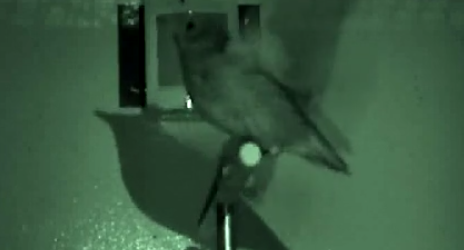
I have a larger post coming out next week as part of a special 10,000 Birds topical extravaganza, so for now just three little things.
First, and this is OLD news, dating to several years go. But did you know that there is a bat that specializes in eating birds that are migrating at night?
Giant Bats Snatch Birds from Night Sky
Every spring, billions of migratory songbirds in Europe fly north to their breeding grounds. Most of these birds fly at night when no predators are around — or so the experts thought. But researchers have now found evidence of a giant European bat that is plucking migrating birds out of the night sky.
Several months ago, a group of bat researchers spent the night recording the sounds of a marshy Spanish forest. When they played the recordings back at full speed, they could only hear the croaking of the frogs. But when the researchers played the recordings back at one-tenth their normal speed, they heard shrieks — the sonar call of a creature called the giant noctule bat or Nyctalus lasiopterus.
Second, and this is recent, new research indicates that Birds that migrate at night enter a state of sleepless mania and gorge on foods by day, behaviors mediated by their biological clocks
Imagine yourself on board a red-eye flight from Los Angeles to New York City, an eight-hour journey that begins at bedtime and ends at breakfast. Your plan to sleep during the flight is thwarted by sporadic turbulence and an uncomfortable seat. When you arrive at John F. Kennedy Airport, you feel dehydrated and grumpy, but you head straight to work for an important meeting. Fast food, caffeine and deadlines fuel your day’s full schedule. That night, you order Chinese takeout and eat it mindlessly in front of your laptop. You want nothing more than a warm shower and a long rest. Unfortunately, it’s time to head back to the airport for another red-eye flight.
And third, related to next week’s post, there is an interesting project being started in North Carolina in which little monitoring devices are being attached to cats to see what they do when running around wild.
A group of researchers at the N.C. Museum of Natural Sciences and N.C. State University has launched perhaps the most ambitious effort ever to understand the secret lives of outdoor cats with the help of tiny satellite tracking harnesses, a 3-D printer and perhaps eventually miniature cat-mounted video cameras to detail behavior as kitty roams the neighborhood.
And daily feces analysis.
Unfortunately these are house cats, not feral, that live outdoors (for some reason). So this may not inform us much of what feral cats are doing. But maybe the research will be extended to address that question. I’ve got a call in with the research team.











Leave a Comment